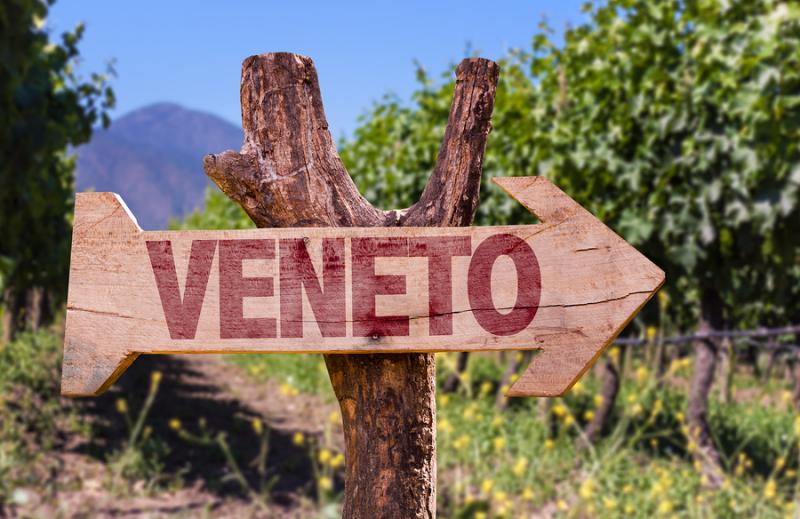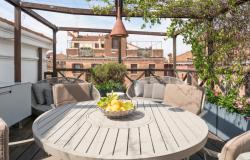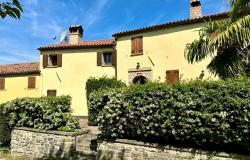Everyone has heard of Prosecco, but what about two rare and wonderful wines from the same area, Friularo and Fior d’Arancio? The vendemmia in the Veneto has been going on since mid September with different varieties of grapes harvested one after the other, starting with the moscato vines at the local vineyard.
We arrive at 8am to find a row of wheelbarrows, baskets for the grapes, boxes of disposable gloves and a pile of forbici (secateurs). Because this is Italy and a mound of paperwork is necessary for every activity, we have to read the detailed safety rules and sign that we have read them, and sign again that as we are not to be paid, we accept that the Cantina will make a donation to charity instead.
The rules and regulations are displayed in the barn, which has agricultural and domestic implements from times gone by fixed to the walls. There are wooden shovels for maize, yokes, ladders, scythes and curious objects which look like sledges or rocking see-saws. I ask what they are for, and am amazed to discover that they are bed warmers. Glowing embers go in the middle on a metal tray, the frame holds a blanket clear of the heat, and the whole contraption slides into a bed.
We march out past the friularo vines, which will be harvested later, to the yellow moscato grapes, hanging in glowing bunches with the morning dew still on them. These grapes are used to make the superb dessert wine, Fior d’Arancio, and are hand picked, as are all the best wines. I’m instructed to cut off any discoloured or shrivelled parts of each bunch, then drop them into plastic panniers which are emptied into wheelbarrows and taken to be gently tipped into the scoop of the tractor, which rises to slide them into a truck lined with tarpaulin.

We work in pairs down each line of vines, chatting and cutting as the sun rises in the sky and the air gets warmer. Hundreds of tiny insects fly around us, but they are harmless, though a nuisance. A praying mantis flits in front of me with wings glinting in the sunshine like a dragon fly. It lands on my next bunch and prays for me before taking off again.
At 10am there’s a coffee break, and everyone emerges from the rows of vines to gather round the tractor for thimblefuls of incredibly strong espresso coffee and biscuits. Fellow pickers are surprised and intrigued to see an inglese in their midst and want to know how I come to be there. We return to the vines, changing partners for another round of fascinating conversations.
We’re a group of all ages and backgrounds, evenly divided between the sexes. Many wear odd hats and shorts, including a large jolly middle-aged woman whose shorts are so skimpy that they disappear under folds of flesh, but nobody notices or cares. A Sherlock Holmes figure is smoking a curly pipe under his tweed hat, probably to deter insects. I’m in an old pair of jeans because I don’t want insect bites, but my fears are groundless: there aren’t any vicious wasps or mosquitoes today.
A young man with special needs wanders up and down chatting and hugging everyone and finds me interesting. He wants to talk about Laurel and Hardy, especially when I tell him that Stanley Laurel came from my part of England. When I explain that not only have I never met him, but that they are both dead, he runs off howling, but it’s soon forgotten and we are friends again as he trundles off with my full wheelbarrow. He’s an accepted and loved part of the group, helping a little and always cheering us on.
The last loads are tipped out and we head back to the farmyard where a long table has been set ready for a communal lunch for 28 people. Wonderful smells drift out from the kitchen. What a feast! Soups, salamis, prosciutto, salads, grilled vegetables, meats, lasagne, meat and aubergine loaf, porcini quiches…Riccardo the proprietario stands at the head of the table and explains about the gold medal-winning friularo wine we’re drinking with our lunch. (See photo)
Friularo grapes are usually picked last, traditionally before St Martin’s Day in November. They are small and black, lightly dusted with a greyish powder, and surprisingly sweet but with tough skins. In the days when Venice was the centre of a huge trading empire, friularo was the wine of choice for merchant vessels because it both travelled and kept well on long journeys. These days wine merchants from Rome and elsewhere arrive to buy consignments of this very special wine. They usually buy from the Villa Widmann at Bagnoli di Sopra, where the great 18th century playwright Goldoni used to stay and have his plays performed in the private theatre.
But back to the vendemmia. In the afternoon, after passing round baskets of fruits and walnuts, (did you know that you can crack two walnuts against each other in your hand? All Italians have the knack) washed down with Raboso, the local sparkling rosé, we drift back to the vineyards. Our task is to cut the prosecco grapes at each end of the long rows, where plastic crates have already been left, squares of bright primary colours in a sea of green. This time we don’t need to be quite so careful in cutting off any shrivelled or blackened fruit. The bunches are huge – like chandeliers – but the grapes are smaller compared with this morning’s moscato variety.

The picking goes on, rather more animatedly after a few glasses of wine. The view along the vines is magical. In the background are the curiously conical Euganean Hills, a group of extinct volcanoes which provide the area’s super-fertile soils, and its D.O.C. wines. The lower slopes are striped with russet, yellow, orange, green and red rows of vines, depending on the variety, making a Bridget Riley canvas of autumn colours.
The prosecco grape is very productive, often bearing as much as four times the amount of fruit as other varieties. It is harvested by machines which cut down the bunches, then draw them up from the ground, but the machines can’t function at the turning points of the rows, which explains why we have to cut by hand. Given that prosecco is now the most popular wine in northern Europe and it is so easy to grow, more acres of this variety are planted every year.
The work is quickly done. Just as well, because it’s now very hot indeed. We return for more dolci, fior d’arancio wine, and knock-out espresso. The chairs are rearranged in a circle and Riccardo brings out his accordion whilst his daughters provide tambourines, castanets and other percussion instruments. We sing (or at least they do) jolly traditional harvest songs, mainly in dialect, with much cheering and clapping. A guitar and an electronic organ join the improvised band and we carry on. I’m amazed they know the words to 30 or 40 songs: I don’t even know the tunes.
By now the hills have become a jagged line of deep purple pointed peaks against the red and gold sky. There’s talk of dancing, but we’re all too tired. Tomorrow the harvesting machines will take over and we’ll wake up slightly stiff, but smiling.
Looking to experience the harvest first-hand next year or this year's olive oil harvest? We have several suggested experiences that can offer this kind of local excursion, Km Zero Tours in Tuscany, these "Farm-to-table" 11 day small group tours and this wine tour in Bologna.









